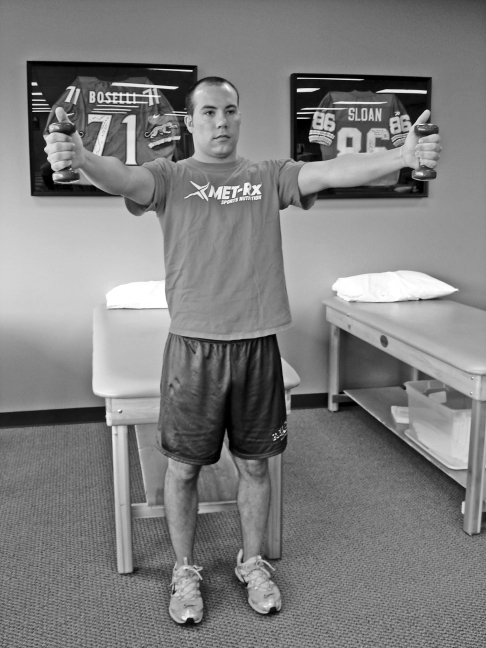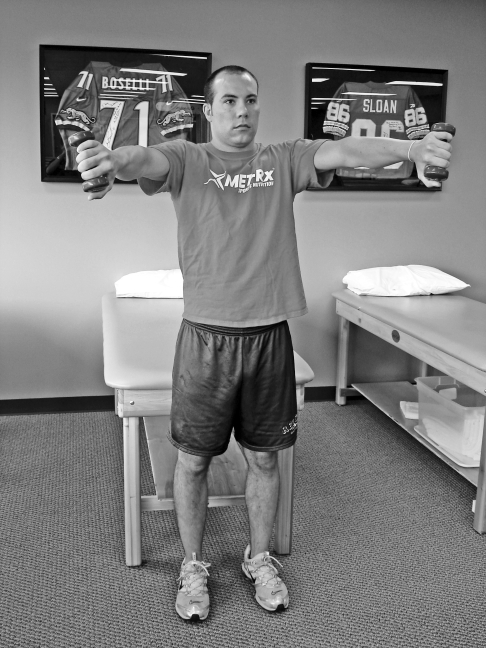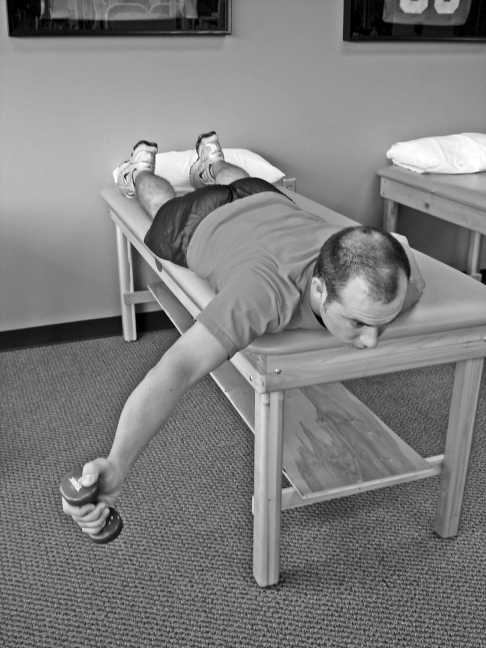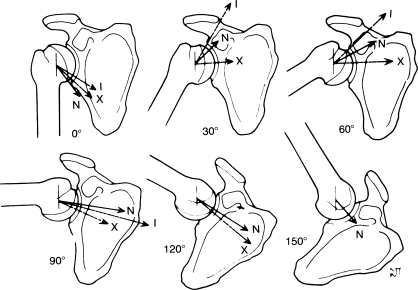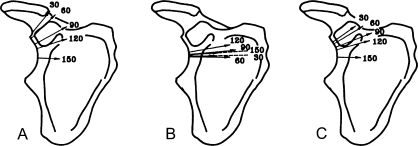Abstract
Context: Investigators have observed electromyographic (EMG) activity of the supraspinatus muscle and reported conflicting results.
Objective: To quantify EMG activity of the supraspinatus, middle deltoid, and posterior deltoid muscles during exercises commonly used in rehabilitation.
Design: One-factor, repeated-measures design.
Setting: Controlled laboratory.
Patients or Other Participants: Twenty-two asymptomatic subjects (15 men, 7 women) with no history of shoulder injury participated.
Main Outcomes Measure(s): The dominant shoulder was tested. Fine-wire EMG electrodes were inserted into the supraspinatus, middle deltoid, and posterior deltoid muscles. The EMG data were collected at 960 Hz for analysis during maximal voluntary isometric contraction (MVIC) and 5 repetitions of 3 exercises: standing elevation in the scapular plane (“full can”), standing elevation in the scapular plane with glenohumeral internal rotation (“empty can”), and prone horizontal abduction at 100° with glenohumeral external rotation (“prone full can”). We calculated 1-way repeated-measures analysis of variance (P < .05) and post hoc 2-tailed, paired t tests to detect significant differences in muscle activity among exercises.
Results: No statistical difference existed among the exercises for the supraspinatus. The middle deltoid showed significantly greater activity during the empty-can exercise (77 ± 44% MVIC) and prone full-can exercise (63 ± 31% MVIC) than during the full-can exercise (52 ± 27% MVIC) (P = .001 and .017, respectively). The posterior deltoid showed significantly greater activity during the prone full-can exercise (87 ± 53% MVIC) than during the full-can (P = .001) and the empty-can (P = .005) exercises and significantly greater activity during the empty-can exercise (54 ± 24% MVIC) than during the full-can exercise (38 ± 32% MVIC) (P = .012).
Conclusions: While all 3 exercises produced similar amounts of supraspinatus activity, the full-can exercise produced significantly less activity of the deltoid muscles and may be the optimal position to recruit the supraspinatus muscle for rehabilitation and testing. The empty-can exercise may be a good exercise to recruit the middle deltoid muscle, and the prone full-can exercise may be a good exercise to recruit the posterior deltoid muscle.
Keywords: shoulder, dynamic stabilization, empty-can exercises, full-can exercises, prone full-can exercises, rotator cuff, scaption
Key Points
The full-can exercise may be the safest and most effective exercise to strengthen the supraspinatus muscle in patients with shoulder lesions.
Compared with the empty-can and prone full-can exercises, the full-can exercise elicited the same amount of supraspinatus activity with the least amount of middle and posterior deltoid muscle activity.
The full-can exercise also may be the best exercise for manual muscle testing of the supraspinatus.
The glenohumeral joint exhibits the greatest amount of motion of any joint in the human body.1 The rotator cuff provides dynamic stability by compressing the humeral head within the concave glenoid fossa during upper extremity motion, which is critical to normal functional activities.2 This synergistic compressive force is necessary to efficiently counteract the superiorly oriented force produced by the larger muscle groups of the shoulder, such as the deltoid, and maintain the centralized position of the humeral head within the glenoid fossa during upper extremity movements.3–5 Pathologic lesions of the rotator cuff, particularly of the supraspinatus muscle, often develop because of an overuse or traumatic injury. Any pathologic condition of the rotator cuff may affect the ability of the rotator cuff to provide this compressive force, resulting in superior humeral head migration and potential impingement against the acromion.6–10 Therefore, a rehabilitation program designed to optimize rotator cuff strength is vital for the patient to regain normal functional activities.
Researchers disagree about the optimal exercises to strengthen the supraspinatus muscle. In several electromyographic (EMG) studies, investigators1,11–17 have attempted to quantify the amount of supraspinatus EMG activity during various exercises along with specific exercise positions in asymptomatic individuals.
Jobe and Moynes18 were the first researchers to recommend elevation in the scapular plane (30° anterior to the frontal plane) with glenohumeral internal rotation, or the “empty-can” exercise, to strengthen the supraspinatus muscle during exercise. Other authors14,16,19–21 have suggested the “full-can” exercise, or elevation in the scapular plane with glenohumeral external rotation, to best strengthen and test the supraspinatus muscle. Furthermore, Blackburn et al12 described a statistically significant increase in supraspinatus activity during prone horizontal abduction at 100° with full external rotation, or the “prone full-can” exercise.
Authors14,15,17,18,22 of several studies have compared these exercises, but the results were inconsistent because of limitations. The studies lacked statistical analysis among exercises17,18 or did not include all 3 recommended exercises14,15,17,22 or the authors did not analyze surrounding deltoid muscle activity.22 Townsend et al17 noted a 10% increase in supraspinatus activity during the empty-can exercise compared with the full-can exercise. However, they did not perform a statistical analysis to document a difference in mean supraspinatus activity between the exercises. Worrell et al22 noted statistically greater supraspinatus EMG activity in the prone full-can exercise than in the empty-can exercise, but total force production (measured using a hand-held dynamometer) was greater in the empty-can exercise. These authors hypothesized that the increase in force production during the empty-can exercise resulted from increased activity of the surrounding musculature rather than of the supraspinatus. Malanga et al15 analyzed the EMG activity of the supraspinatus, as well as 9 other muscles, during the empty-can and prone full-can exercises to assess the hypothesis of Worrell et al.22 The authors reported no statistical difference in supraspinatus activity; however, the anterior deltoid demonstrated statistically greater activity during the empty-can exercise, and the posterior deltoid exhibited statistically greater activity during the prone full-can exercise. Middle deltoid activity was high during both exercises.
The results of these studies remain inconclusive. Thus, controversy regarding the best exercise to strengthen the supraspinatus exists. It appears that the optimal exercise for the supraspinatus would elicit the greatest amount of supraspinatus activity while minimizing the surrounding muscular activity, particularly the deltoid. However, no studies comparing the EMG activity of the supraspinatus and deltoid musculature during all 3 exercises have been published. Therefore, the purpose of our investigation was to measure dynamically the normalized EMG activity of the supraspinatus, middle deltoid, and posterior deltoid musculature during the full-can, empty-can, and prone full-can exercises.
METHODS
Design
For our controlled laboratory study, we used a 1-factor repeated-measures design to compare the EMG activity during full-can, empty-can, and prone full-can exercises for each of the supraspinatus, middle deltoid, and posterior deltoid muscles. Data were collected from the dominant shoulder of healthy adult subjects.
Subjects
Twenty-two asymptomatic subjects (15 men, 7 women; age = 26.7 ± 7 years, height = 175 ± 10 cm, mass = 79 ± 18 kg) volunteered to participate in our study. Twenty were right-hand dominant; 2, left-hand dominant. No subject reported a history of shoulder pain, injury, or instability. Each subject gave informed consent. The research protocol was approved by the institutional review board.
Instruments
We used the MyoSystem 2000 EMG instrument (Noraxon USA Inc, Scottsdale, AZ) to collect EMG data. The amplifier of the system was differential with a bandwidth of 10 Hz to 1000 Hz. A fourth-order Butterworth low-pass filter with a cut-off frequency of 1000 Hz was included in the amplifier as an anti-aliasing filter. The high-pass portion of the filter was a first-order type with a cut-off frequency of 10 Hz. The input impedance was more than 10 MΩ, and the common mode rejection ratio was more than 100 dB at 60 Hz. The average gain was between 960 Hz and 1040 Hz.
Electrode Insertion
The selection of all muscles for and the technique of electrode insertion were performed according to Perotto.23 We selected electrodes that were 44-gauge stainless steel, paired hook wires with a dimension of 100 mm. The interelectrode distances were planned carefully to minimize the electrode cross-talk. An investigator (M.T.E.) experienced with the use and placement of intramuscular electrodes inserted all electrodes. The skin of each dominant shoulder was shaved and cleaned with alcohol before electrode insertion. Ethyl chloride was sprayed onto the skin to help minimize the discomfort from electrode insertion. Electrode placement was assisted by palpation and visual inspection of each muscle. The investigator inserted the electrodes into the supraspinatus, middle deltoid, and posterior deltoid muscles using a 27-gauge, 30-mm needle as a cannula (Nicolet Biomedical, Madison, WI). Electrodes were inserted into the supraspinatus 1.5 cm superior to the midpoint of the spine of the scapula.23 For the supraspinatus muscle, the needle was inserted to the supraspinous fossa of the scapula. Electrodes were inserted into the muscle belly of the posterior deltoid 2.5 cm inferior to the posterior margin of the acromion.23 Electrodes for the middle deltoid were inserted into the muscle belly at a point halfway between the tip of the acromion and the deltoid tubercle.23 A reference surface electrode was attached above the olecranon.
The inserted wires were attached to bipolar leads of the MyoSystem 2000. The subject's shoulder was moved passively through the available range of motion, and the subject was instructed to actively elevate and rotate the shoulder. The subject performed resisted isometric contractions for the supraspinatus, middle deltoid, and posterior deltoid. As recommended by Kelly et al,24 we included passive, active, and resisted movements to ensure subject comfort, to ensure quality of EMG data, and to fix the wire hooks within each muscle being tested.
Maximal Voluntary Isometric Contraction
To obtain the maximal voluntary isometric contraction (MVIC) for each muscle tested, we directed each subject to perform a series of resisted isometric contractions. For the supraspinatus, the shoulder was elevated to 90° in the scapular plane, the elbow was extended, and the shoulder was in neutral rotation.25 For the middle deltoid, the arm was abducted to 90° and in neutral rotation (palm down) with resistance applied just proximal to the elbow in an inferior direction.25 For the posterior deltoid, the arm was abducted to 90° and in neutral rotation with resistance applied just proximal to the elbow in an anterior direction.25
Exercises
All testing was performed in the presence of one of the investigators (M.M.R.) to ensure proper body positioning without compensatory movements during data collection. The subjects performed 3 shoulder rehabilitation exercises in a randomized sequence established before data collection. The exercises performed were standing elevation in the scapular plane (30° anterior to the frontal plane) from 0° to 90° with glenohumeral external rotation, or full can (Figure 1); standing elevation in the scapular plane from 0° to 90° with glenohumeral internal rotation, or empty can (Figure 2); and prone horizontal abduction at 100° with glenohumeral external rotation, or prone full can (Figure 3). The subject was instructed to perform the prone full-can exercise to end range of elevation and to stop when the investigator noted compensatory motion. Each subject performed 5 repetitions of each exercise. The speed of each repetition was regulated by a metronome set to 60 beats/min. The concentric and eccentric phases of each repetition were performed during 1 beat each. The subject rested between 3 and 5 minutes after each exercise.
Figure 1. The full-can exercise. The subject elevates the upper extremity at approximately 30° of horizontal abduction in the plane of the scapula and full glenohumeral external rotation.
Figure 2. The empty-can exercise. The subject elevates the upper extremity at approximately 30° of horizontal abduction in the plane of the scapula and full glenohumeral internal rotation.
Figure 3. The prone full-can exercise. The subject performs prone horizontal abduction at approximately 100° of glenohumeral abduction and full external rotation.
While performing each exercise, the subject held a dumbbell selected by one of the investigators (M.M.R.). The investigator determined the dumbbell mass for each subject during a testing session before the EMG data collection. The dumbbell mass chosen was the maximal mass that the subject could use during each exercise while maintaining proper form for 10 repetitions and maintaining proper cadence (10-repetition maximum). Mean mass used for each exercise was 1.85 ± 0.64 kg for the full-can and empty-can exercises and 1.53 ± 0.53 kg for the prone full-can exercise.
Data Collection and Processing
Data collection and processing were similar to methods previously used by Reinold et al,16 who reported their reliability. Data for each trial were collected at 960 Hz.22 The data were processed with a 25-Hz high-pass filter, rectified, and smoothed using a 100-millisecond moving average window.
During the MVIC trials, the subject was instructed to “ramp up” to maximal effort. The investigator verbally encouraged the subject to reach and maintain maximal effort while EMG data were collected for 5 seconds. After collecting the data for each trial, the investigator instructed the subject to relax. The EMG data during the first and last second of each MVIC trial were discarded, and the remaining 3 seconds of data were used for analysis. Peak value then was identified as MVIC.26 Each muscle was tested once.
The first and fifth repetitions for each exercise were eliminated from the analysis. The peak values of EMG data for repetitions 2, 3, and 4 were averaged for each muscle. Results were normalized by expressing the peak EMG value for each muscle and for each exercise as a percentage of the MVIC of the corresponding muscle. Thus, the peak EMG values expressed in percentage of MVIC values for each muscle were averaged for the subject's 3 repetitions.
Statistical Analysis
Statistical analysis was performed using SPSS statistical software (version 10.0; SPSS Inc, Chicago, IL). The EMG differences among the 3 exercises were tested for statistical significance (P < .05) using a 1-way repeated-measures analysis of variance for each muscle. When we found a significant difference, we used post hoc 2-tailed paired t tests to determine which values were significantly different. The step-down Bonferroni-Holm adjustment was applied to keep the overall significance level at .05.
Power analysis was performed to determine whether the number of subjects would be sufficient. Assuming that a power of 0.8 and α level of .05 are desired and the difference of the means among exercises must be at least 10% of MVIC to be clinically relevant, at least 20 subjects were needed if the SD of the difference of means was 15% of MVIC. Thus, the number of subjects used was a reasonable sample for the differences expected and of interest.
RESULTS
Results of our study are listed in the Table. The difference in supraspinatus muscle activity among the full-can, empty-can, and prone full-can exercises was not statistically significant (F2,40 = 0.215, P = .807). For the posterior deltoid, muscle activity among the 3 exercises was significantly different (F1.33,25.31 = 12.721, P = .001). Post hoc analysis of the posterior deltoid data revealed that muscle activity was significantly greater for the prone full-can exercise than for the full-can (t19 = −3.956, P = .001) and empty-can (t19 = −3.174, P = .005) exercises and was significantly greater for the empty-can exercise than for the full-can exercise (t19 = 2.791, P = .012). The difference in middle deltoid activity among the 3 exercises was statistically significant (F1.29,21.89 = 4.939, P = .029). Post hoc analysis for the middle deltoid revealed that muscle activity was significantly greater for the empty-can and prone full-can exercises than for the full-can exercise (t17 = 2.838, P = .011, and t17 = −2.651, P = .017, respectively).
Electromyographic Activation Expressed as a Percentage of Maximal Voluntary Isometric Contraction for Each Exercise.
DISCUSSION
We analyzed and compared the amount of supraspinatus, middle deltoid, and posterior deltoid activity during all 3 commonly recommended exercises and, thus, avoided the limitations of previous studies.14,15,17,18,22 The results of our study showed that all 3 exercises provided a similar amount of supraspinatus activity, ranging from 62% through 67% of MVIC. However, the full-can exercise demonstrated the lowest amount of middle and posterior deltoid activity. These results are similar to those of Kelly et al14 and Malanga et al,15 who reported no difference in supraspinatus activity but less activity in surrounding muscles during the full-can exercise.
Our results were also similar to the results of a study by Takeda et al.21 Rather than using EMG, the authors21 used magnetic resonance imaging to measure changes in T2 relaxation time of the rotator cuff and deltoid muscles. The authors noted that increases in the muscle proton T2 relaxation times have been shown to have a positive correlation with muscle activity. They found similar supraspinatus relaxation times between the empty-can and full-can exercises, with more activity in surrounding muscles during the empty-can and prone full-can exercises.
Our results were different from the results of Blackburn et al12 and Worrell et al,22 who reported that supraspinatus activity was greater during the prone full-can exercise than during the empty-can exercise. The differences between our results and those of other studies12,22 may be related to several factors, including differences in subjects, EMG method, and statistical analysis, as well as the limitations of EMG measurements in general. The limited sampling rate and bandwidth in our study may have affected the absolute magnitudes of the EMG data but most likely did not affect the comparisons and overall findings. Our EMG method was similar to the methods of other researchers.12,14,16 One advantage of our study was that we analyzed the supraspinatus, middle deltoid, and posterior deltoid muscles during all 3 exercises; thus, the results may be more useful than the results of previous studies in which investigators analyzed the muscles and tests individually.
In a biomechanical report, Poppen and Walker20 showed that the resultant force vector of the supraspinatus (humeral compressor and elevator) and the anterior and middle deltoids (humeral elevators) during glenohumeral elevation with external rotation (full can) was oriented in a centralized fashion to the glenoid fossa (Figure 4). Conversely, a greater superior shear force vector resulted from glenohumeral elevation with internal rotation (empty can) at 30° and 60° than from glenohumeral elevation with the humerus in neutral or external rotation. The results of our study may help to explain why this may occur. The higher EMG activity of the middle deltoid during the empty-can exercise relative to the other 2 exercises may result in a superiorly directed shear force.
Figure 4. The resultant force vectors of the shoulder during arm elevation with the arm in neutral (N), external rotation similar to the full-can exercise (X) and internal rotation similar to the empty-can exercise (I). Note the superiorly oriented force vector with internal rotation at 30° and 60° of elevation.20 Reprinted with permission from Poppen NK, Walker PS. Forces at the glenohumeral joint in abduction. Clin Orthop Relat Res. 1978;135:165–170.
Morrey et al1 showed that the resultant force vector of the rotator cuff consistently produced a centralizing force that would aid in producing a compressive force of the humerus within the glenoid (Figure 5). Conversely, the deltoid exhibited a superiorly directed force vector from 0° to 90°. Our results demonstrated increased EMG activity in the middle and posterior deltoids during the empty-can and prone full-can exercises when compared with the full-can exercise.
Figure 5. The resultant force vectors of the deltoid (A), supraspinatus (B), and combined deltoid and supraspinatus (C) during arm elevation from 30° to 150°. Note the superiorly oriented force vector of the deltoid (A) from 30°–120° of elevation when simultaneous supraspinatus activity is not present. The supraspinatus (B) provides a compressive force that centralizes the humeral head within the glenoid fossa throughout the range of motion.1 This figure was published in Rockwood CA, Matsen FA, eds, The Shoulder, Morrey BF, Itoi, E, An KA, Biomechanics of the shoulder, 233–276, Copyright WB Saunders 1998.
Activities that produce higher levels of deltoid activity in relation to supraspinatus activity may be detrimental in patients with shoulder pain, weakness of the rotator cuff, and inefficient dynamic stabilization. This is due to the increased amount of superior humeral head migration that occurs when the rotator cuff does not adequately compress the humerus within the glenoid fossa to counteract the superior pull of the deltoid. This superior humeral head migration may result in subacromial impingement and may facilitate tendon degeneration and eventual failure.
Although we analyzed EMG patterns in asymptomatic patients, we believe that the full-can exercise may be the most appropriate exercise to minimize middle deltoid activity while eliciting supraspinatus activity in symptomatic patients, as well. Clinically, the superior humeral head migration that may occur with the empty-can and prone full-can exercises may be disadvantageous to symptomatic patients with rotator cuff lesions or a deficiency in glenohumeral dynamic stabilization. This partially may explain why the empty-can exercise often elicits a certain amount of pain and discomfort in patients.
From an anatomical and biomechanical standpoint, the full-can exercise also may be the most beneficial exercise and provoke the least amount of pain because of the increased amount of subacromial space6,7,27 and increased moment arm of the supraspinatus muscle8,9 in this position compared with the empty-can or prone full-can exercise.
Based on the EMG results of the study, we also suggest using the full-can exercise for manual muscle testing of the supraspinatus because it produces minimal muscle activity of the middle and posterior deltoids relative to the empty-can exercise. The full-can exercise can be used to test the function of the supraspinatus with the least amount of surrounding deltoid muscle activity. The empty-can exercise may be used as a provocative test to assess the ability of the rotator cuff to dynamically stabilize the humeral head and prevent superior migration and subsequent impingement.
Any EMG study has limitations, including reliability and validity. Our study represents a common application of EMG during rehabilitation exercises. Every effort was made to maximize the reliability and validity of the results. Our methods and electrode placement were similar to those of previous studies.16 During data collection, each subject used proper form while working at an intensity level consistent with a 10-repetition maximum trial.
We analyzed the EMG response of these exercises in young, asymptomatic patients. Future studies should involve groups of asymptomatic and symptomatic subjects with varied ages and lesions. Furthermore, we did not assess the role of other muscle groups, specifically the other rotator cuff muscles. Future research may be warranted to assess these muscles and their contributions to the exercises included in our study.
CONCLUSIONS
Our findings suggest that supraspinatus, middle deltoid, and posterior deltoid muscle activity is varied based on the position of the exercise performed. While we noted similar supraspinatus muscle activity between exercises, we observed significantly greater deltoid activity during the empty-can and prone full-can exercises. Thus, the full-can exercise may be best to maximize the amount of supraspinatus activity with the least amount of deltoid muscle activity.
REFERENCES
- Morrey BF, Itoi E, An KA. Biomechanics of the shoulder. In: Rockwood CA, Matsen FA, eds. The Shoulder. Philadelphia, PA: WB Saunders; 1998:233–276.
- Wilk KE, Arrigo C. Current concepts in the rehabilitation of the athletic shoulder. J Orthop Sports Phys Ther. 1993;18:365–378. doi: 10.2519/jospt.1993.18.1.365. [DOI] [PubMed] [Google Scholar]
- Bassett RW, Browne AO, Morrey BF, An KN. Glenohumeral muscle force and movement mechanics in a position of shoulder instability. J Biomech. 1990;23:405–415. doi: 10.1016/0021-9290(90)90295-e. [DOI] [PubMed] [Google Scholar]
- De Duca CJ, Forrest WJ. Force analysis of individual muscles acting simultaneously on the shoulder joint during isometric abduction. J Biomech. 1973;6:385–393. doi: 10.1016/0021-9290(73)90098-5. [DOI] [PubMed] [Google Scholar]
- Inman VT, Saunders JB, Abbott LC. Observations of the function of the shoulder joint. J Bone Joint Surg Br. 1944;26:1–30. doi: 10.1097/00003086-199609000-00002. [DOI] [PubMed] [Google Scholar]
- Brossmann J, Preidler KW, Pedowitz RA, White LM, Trudell D, Resnick D. Shoulder impingement syndrome: influences of shoulder position on rotator cuff impingement: an anatomic study. AJR Am J Roentgenol. 1996;167:1511–1515. doi: 10.2214/ajr.167.6.8956588. [DOI] [PubMed] [Google Scholar]
- Graichen H, Bonel H, Stammberger T, Englmeier KH, Reiser M, Eckstein F. Subacromial space width changes during abduction and rotation — a 3-D MR imaging study. Surg Radiol Anat. 1999;21:59–64. doi: 10.1007/BF01635055. [DOI] [PubMed] [Google Scholar]
- Juul-Kristensen B, Bojsen-Moller F, Finsen L. Muscle sizes and moment arms of rotator cuff muscles determined by magnetic resonance imaging. Cell Tissues Organs. 2000;167:214–222. doi: 10.1159/000016784. et al. [DOI] [PubMed] [Google Scholar]
- Otis JC, Jiang CC, Wickiewicz TL, Peterson MG, Warren RF, Santner TJ. Changes in the moment arms of the rotator cuff and deltoid muscles with abduction and rotation. J Bone Joint Surg Am. 1994;76:667–676. doi: 10.2106/00004623-199405000-00007. [DOI] [PubMed] [Google Scholar]
- Sharkey NA, Marder RA. The rotator cuff opposes superior translation of the humeral head. Am J Sports Med. 1995;23:270–275. doi: 10.1177/036354659502300303. [DOI] [PubMed] [Google Scholar]
- Ballantyne BT, O'Hare SJ, Paschall JL. Electromyographic activity of selected shoulder muscles in commonly used therapeutic exercises. Phys Ther. 1993;73:668–677. doi: 10.1093/ptj/73.10.668. et al. [DOI] [PubMed] [Google Scholar]
- Blackburn TA, McLeod WD, White B, Wofford L. EMG analysis of posterior rotator cuff exercises. Athl Train J Natl Athl Train Assoc. 1990;25:40–45. [Google Scholar]
- Jobe FW, Tibone JE, Perry J, Moynes D. An EMG analysis of the shoulder in throwing and pitching: a preliminary report. Am J Sports Med. 1983;11:3–5. doi: 10.1177/036354658301100102. [DOI] [PubMed] [Google Scholar]
- Kelly BT, Kadrmas WR, Speer KP. The manual muscle examination for rotator cuff strength: an electromyographic investigation. Am J Sports Med. 1996;24:581–588. doi: 10.1177/036354659602400504. [DOI] [PubMed] [Google Scholar]
- Malanga GA, Jenp YN, Growney ES, An K. EMG analysis of shoulder positioning in testing and strengthening the supraspinatus. Med Sci Sports Exerc. 1996;28:661–664. doi: 10.1097/00005768-199606000-00003. [DOI] [PubMed] [Google Scholar]
- Reinold MM, Wilk KE, Fleisig GS. Electromyographic analysis of the rotator cuff and deltoid musculature during common shoulder external rotation exercises. J Orthop Sports Phys Ther. 2004;34:385–394. doi: 10.2519/jospt.2004.34.7.385. et al. [DOI] [PubMed] [Google Scholar]
- Townsend H, Jobe FW, Pink M, Perry J. Electromyographic analysis of the glenohumeral muscles during a baseball rehabilitation program. Am J Sports Med. 1991;19:264–272. doi: 10.1177/036354659101900309. [DOI] [PubMed] [Google Scholar]
- Jobe FW, Moynes DR. Delineation of diagnostic criteria and a rehabilitation program for rotator cuff injuries. Am J Sports Med. 1982;10:336–339. doi: 10.1177/036354658201000602. [DOI] [PubMed] [Google Scholar]
- Itoi E, Kido T, Sano A, Urayama M, Sato K. Which is more useful, the “full can test” or the “empty can test,” in detecting the torn supraspinatus tendon? Am J Sports Med. 1999;27:65–68. doi: 10.1177/03635465990270011901. [DOI] [PubMed] [Google Scholar]
- Poppen NK, Walker PS. Forces at the glenohumeral joint in abduction. Clin Orthop Relat Res. 1978;135:165–170. [PubMed] [Google Scholar]
- Takeda Y, Kashiwaguchi S, Endo K, Matsuura T, Sasa T. The most effective exercise for strengthening the supraspinatus muscle: evaluation by magnetic resonance imaging. Am J Sports Med. 2002;30:374–381. doi: 10.1177/03635465020300031201. [DOI] [PubMed] [Google Scholar]
- Worrell TW, Corey BJ, York SL, Santiestaban J. An analysis of supraspinatus EMG activity and shoulder isometric force development. Med Sci Sports Exerc. 1992;24:744–748. [PubMed] [Google Scholar]
- Perotto AO. Anatomical Guide for the Electromyographer: The Limbs and Trunk. Springfield, IL: Charles C. Thomas; 1994:90–103.
- Kelly BT, Cooper LW, Kirkendall DT, Speer KP. Technical considerations for electromyographic research on the shoulder. Clin Orthop Relat Res. 1997;335:140–151. [PubMed] [Google Scholar]
- Hislop HJ, Montgomery J. Daniels and Wortingham's Muscle Testing: Techniques of Manual Examination. 6th ed. Philadelphia, PA: WB Saunders; 1995:81–96.
- Zheng N, Fleisig GS, Escamilla RF, Barrentine SW. An analytical model of the knee for estimation of internal forces during exercise. J Biomech. 1998;31:963–967. doi: 10.1016/s0021-9290(98)00056-6. [DOI] [PubMed] [Google Scholar]
- Thigpen CA, Padua DA, Morgan A, Kreps C, Karas SG. Scapular kinematics during supraspinatus rehabilitation exercise: a comparison of full-can versus empty-can techniques. Am J Sports Med. 2006;34:644–652. doi: 10.1177/0363546505281797. [DOI] [PubMed] [Google Scholar]



